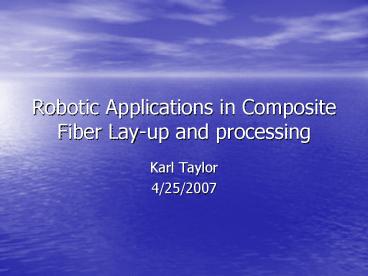Robotic Applications in Composite Fiber Layup and processing PowerPoint PPT Presentation
1 / 11
Title: Robotic Applications in Composite Fiber Layup and processing
1
Robotic Applications in Composite Fiber Lay-up
and processing
- Karl Taylor
- 4/25/2007
2
Composite fiber manufacture can be troublesome
for several reasons
- Solvents used in thermoplastic and thermo-set
resins for composite fiber lay-ups are often
teratogenic (causing birth defects),
carcinogenic, and may cause hormonal problems - Fiber material (often referred to as tow) can
present moderate handling hazards to skin and
eyes - Fiber material can easily be damaged or become
fouled in its orientation during lay-up due to
handling error
3
Composite Fiber additionally requires specialized
handling
- Pre-impregnated fiber/resin cloth (pre-preg
material) must be carefully monitored for
duration of time at room temperature, as material
properties degrade with time out of freezer due
to warm curing - In cases where resin is applied to fiber
in-process, resin has limited life span due to
same reasons as above
4
Manufacturing associated costs contribute from
40 to over 60 of total costs for producing
fiber composite products.
5
Industrial Robotic technology could reduce this
cost by over half through
- Reduced required facility floor space for lay-up
processing - Improved control of material handling
- Reduced labor requirements/costs
- Faster Process time
- Reduced scrap due to human processing error
6
Additionally, Robotics promises these additional
benefits
- Reduced exposure of human labor element to toxic
solvents, and handling hazards or fiber tow
material used in fiber composite manufacture - Reduced cost for more sophisticated/higher
performance composites
7
Robotic application benefits (cont.)
- Improved capacity to fabricate much larger single
piece composite lay-ups - Examples
- -Single piece fiber composite aircraft fuselage
lay- ups - -Moderate sized marine hull single piece
composite lay-up - Processing any large single piece lay-up that was
previously too costly, difficult or impossible to
manufacture by hand
Right CAD representation of automated composite
assembly/lay-up using a combination six-axis
arm/3-axis gantry system (source
http//www.compositemfg.com/)
8
Robotics Applications (cont.)
Above, left Proprietary Precision Feed
Endeffector (PFE), provides pressure mandrels,
orientation, excess resin recycling, and shearing
capabilities Above, right PFE applying pre-preg
material to a concave mold Right Detail of
optional refrigerator capabilities for preserving
composite material for extended duration
lay-ups Source Composite Systems, Inc.
(http//www.compositemfg.com)
9
Robotics Applications (cont.)
Above, left A three-axis gantry system with a
mounted Kuka six-axis arm for performing large
single part composite assembly Above, right
Detail of six-axis arm mounted on telescoping
vertical axis, may be used in conjunction with a
PFE TCF Source Composite Systems, Inc.
(http//www.compositemfg.com)
10
Robotics Applications (cont.)
Above, left tandem arms working in parallel on a
single gantry system to assemble mirrored parts
(i.e. a pair of composite wings) Above, right
single gantry system allowing lay-up within the
cylinder, as would occur for ID assmbly of a
fuselage Right Similar to above, with OD
single-piece assembly Source Composite Systems,
Inc. (http//www.compositemfg.com)
11
Robotics Applications Summary
- Multi-axis gantry system conveyors (for
especially large parts) enable manufacture of
parts previously impossible, or infeasible - Specialized TCF modules that handle fiber
orientation, mandrel application force, recycling
excess resin, and temperature control of
composite material can do the work of dozens of
laborers more efficiently than traditional
methods - Robotics greatest advantage over traditional
automation of composite lay-up is in flexibility
of configuration and adaptability to several
assembly operations
(Source http//www.compositemfg.com/PFE20Technol
ogy.htm)

